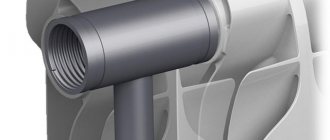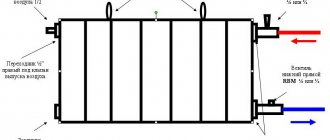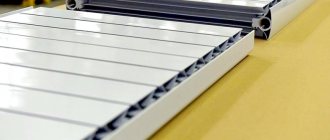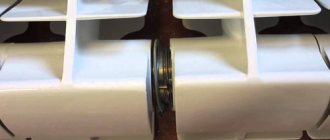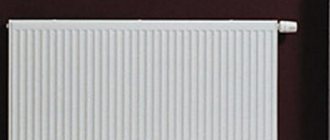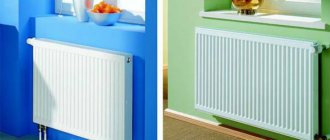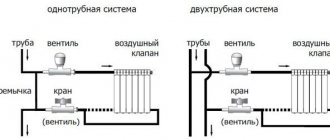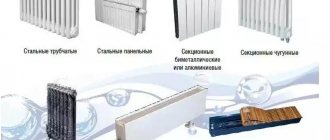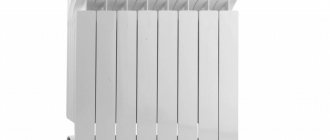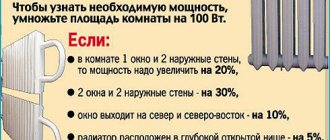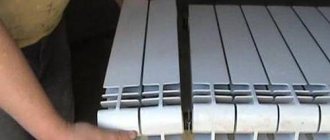A bimetallic radiator is a heating device in which coolant circulates through a steel core placed inside an aluminum casing. Batteries of this type belong to sectional heating devices and operate on the principle of combined (convective and radiant) heat exchange.
The technical characteristics of bimetallic heating radiators include a number of parameters and design features that allow you to evaluate the heating device and compare it with other models of a similar size.
What is heat transfer
Bimetallic heating radiator
The definition of heat transfer comes down to a couple of simple words - it is the amount of heat generated by a radiator over a certain period of time. Radiator power, thermal power, heat flow - the designation of one concept and is measured in Watts. For 1 section of a bimetallic radiator, this number is 200 W.
Heat transfer table for heating radiators
Some documents contain heat transfer values calculated in calories per hour. To avoid confusion, calories are easily converted to Watts using simple calculations (1 Watt = 859.8 cal/hour).
Heat from the battery warms the room through three processes:
- heat exchange;
- convection;
- radiation.
Room heating process
Each model of heating devices uses all types of heating, but in different proportions. For example, a radiator is considered to be those batteries that transfer 25% of thermal energy into the surrounding space through radiation. But now the term “radiator” has begun to be used to describe any heating device, regardless of the main heating method.
Parameters to be taken into account when calculating
Approximate calculations are attractive due to their simplicity, but do not provide reliable information. As a result, the apartment owner may freeze, or overpay for the installation of expensive radiators.
An accurate calculation must take into account many correction parameters:
- Glazing condition;
- Number of external walls;
- Their thermal insulation;
- Thermal conditions of the upper room;
- Climatic characteristics of the region and other parameters.
Dimensions and capacity of sections
Due to steel inserts, bimetallic radiators are more compact than aluminum, cast iron, and steel models. To some extent, this is not bad; the smaller the section, the less coolant is required for heating, which means that the battery is more economical in terms of heat energy consumption. However, too narrow pipes quickly become clogged with debris and rubbish, which are inevitable companions in modern heating networks.
Debris and dirt in the radiator
Good models of bimetal radiators have steel cores inside that are as thick as the walls of a regular water pipe. The heat transfer of the battery depends on the capacity of the sections, and the interaxial distance directly affects the capacity parameters:
- 20 cm - 0.1-0.16 l;
- 35 cm - 0.15-0.2 l;
- 50 cm - 0.2-0.3 l.
From the given data it follows that bimetal radiators require a small amount of coolant. For example, a heating device made of ten sections 35 cm high and 80 cm wide holds only 1.6 liters. Despite this, the heat flow is sufficient to warm the air in a room of 14 square meters. m. It is worth considering that a battery of this size weighs almost twice as much as its aluminum counterparts - 14 kg.
The vast majority of bimetal batteries can be purchased in specialized stores in one section and assembled a radiator of exactly the size required by the room. This is convenient, although there are one-piece models with a fixed number of sections (usually no more than 14 pieces). Each part has four holes: two inlets and two outlets. Their sizes may vary depending on the model of the heating device. To make it easier to assemble bimetal radiators, two holes are made with right-hand threads, and two with left-hand threads.
Assembly of bimetallic heating radiators
Fins
The fins serve to increase the total heat transfer area of the heating device. Modern models use various design solutions that make fins more efficient.
The efficiency of heat transfer is increased by introducing additional fins into the structure, as well as by profiling convection channels between the ribs. In Tenrad radiators, the channels form a confuser, due to which the air flow speed increases, which increases the intensity of convective heat transfer. The outer edges of the ribs are rounded to increase injury safety.
Six-section radiators.
How to choose the right number of sections
The heat output of bimetallic heating devices is indicated in the data sheet. Based on this data, all necessary calculations are made. In cases where the heat transfer value is not indicated in the documents, these data can be viewed on the official websites of the manufacturer or used in the calculations the average value. For each individual room, its own calculation must be carried out.
To calculate the required number of bimetal sections, you need to take into account several factors. The heat transfer parameters of bimetal are slightly higher than those of cast iron (taking into account the same operating conditions. For example, let the coolant temperature be 90 ° C, then the power of one section of bimetal is 200 W, of cast iron - 180 W).
Radiator heating power calculation table
If you are planning to replace a cast-iron radiator with a bimetallic one, then with the same dimensions, the new battery will heat a little better than the old one. And this is good. It is worth considering that over time the heat transfer will be slightly less due to blockages inside the pipes. Batteries become clogged with deposits that appear due to metal contact with water.
Therefore, if you decide to replace it, then calmly take the same number of sections. Sometimes batteries are installed with a small margin in one or two sections. This is done to avoid loss of heat transfer due to clogging. But if you are purchasing batteries for a new room, you cannot do without calculations.
Why do you need a UPS (UPS)
The principle of operation of a UPS is revealed in the name - it is a source at the output of which there is always voltage. But we are technical realists gathered here, and we understand that nothing is eternal, so below we will understand the principle of operation.
UPSs are mainly used where a power failure can cause negative consequences. For example, power supply for computers and servers, power supply for communication and signal distribution devices (routers), power supply for devices whose automatic reboot (restart) is impossible without human intervention.
For household items, these are primarily computers and heating systems.
It should be understood that UPSs are selected for a load operating time of 10-15 minutes, rarely up to half an hour. It is assumed that during this time the power will appear, or the person (operator) will take the necessary actions (save the data, call the enterprise’s energy service, complete the technological process).
The UPS should not be considered as a backup power source. It is only an emergency source, and at best is used very rarely, for a total of no more than 10 minutes per year (several times, for a period of no more than a minute). If this time is longer, then you should think about improving the quality of the power supply.
automatic transfer of reserve generatorsolar battery
Calculation by dimensions
The heat output of radiators depends on the volume of the room that needs to be heated. The larger the room, the more sections will be required. Therefore, the simplest calculation is based on the area of the room.
There are special standards for plumbing, strictly regulated by SNiP. Batteries are no exception. For buildings in a temperate climate zone, the standard heating power is 100 W per square meter of room. Having calculated the area of the room, multiplying the width by the length, you must also multiply the resulting value by 100. This will give you the total heat transfer of the battery. All that remains is to divide it into the heat transfer parameters of the bimetal.
Formula for calculating the number of sections according to the dimensions of the room
For a room 3x4 m, the calculation will look like this: K = 3x4x100/200 = 6 pcs. The formula is extremely simple, but allows you to calculate only the approximate number of bimetal sections. These calculations do not take into account such important parameters as:
- ceiling height (the formula is more or less accurate for ceilings no higher than 3 m);
- location of the room (north side, corner of the house);
- number of window and door openings;
- degree of insulation of external walls.
How hot should the battery get?
Window
Most often, it is these structural elements that become the culprits of leakage from 14 to 30% of heat. For a more accurate calculation, you need to take into account their size and level of insulation. This explains the presence of two calculated coefficients.
Ratio of window area to floor area:
- 10% — 0,8
- 20% — 0,9
- 30% — 1,0
- 40% — 1,1
- 50% — 1.2
The last number is the coefficient.
Type of double glazed windows:
- Three-chamber - 0.85.
- Double-chamber - 1.0.
- Wooden double frames - 1.27 or 1.3.
When considering walls and roofing, the type of material and insulation is taken into account: therefore, there are also two coefficients.
Insulation:
- A brick wall of normal thickness is used as a basis. The coefficient is equal to one.
- For small thicknesses, the coefficient is taken as 1.27.
- Well-insulated structures with a thermal insulation thickness of at least 10 cm: correction number 0.8.
Calculation by volume
Calculating the heat transfer of a battery by room volume is a little more complicated. To do this, you will need to know the width, length and height of the room, as well as the heating standards established for one m3 - 41 W.
What kind of heat transfer should bimetallic radiators have for a room 3x4 m, taking into account the ceiling height of 2.7 m: V = 3x4x2.7 = 32.4 m3. Having received the volume, it is easy to calculate the heat transfer of the battery: P = 32.4x41 = 1328.4 W.
As a result, the number of sections (taking into account the thermal power of the battery at high temperature mode 200 W) will be equal to: K = 1328.4/200 = 6.64 pcs. The resulting number, if it is not an integer, is always rounded up. Based on more accurate calculations, you will need 7 sections, not 6.
Easy way
There is another way to determine the volume of coolant, which does not require the possession of any information. Everything is extremely simple. Close all the caps on the battery and fill it with water using a measuring container. At the same time, naturally, you count how much liquid got in.
At the end of the procedure, drain everything accumulated from the radiator. Of course, all these operations must be performed either in the bathroom or in the yard so as not to flood the house. Based on the obtained indicator, you can easily navigate the total volume of coolant for your heating system. Good luck!
Correction factors
Despite the same values in the data sheet, the actual heat transfer of radiators may differ depending on operating conditions. Considering that the above formulas are accurate only for houses with average insulation rates and for areas with a temperate climate, under other conditions it is necessary to introduce amendments to the calculations.
Correction factors when calculating the number of heating radiator sections
To do this, the value obtained during the calculations is additionally multiplied by a coefficient:
- corner and northern rooms - 1.3;
- regions with extreme frosts (Far North) - 1.6;
- screen or box - add another 25%, niche - 7%;
- for each window in the room, the total heat transfer for the room increases by 100 W, for each door - 200 W;
- cottage - 1.5;
Important! The last coefficient when calculating bimetallic radiators is used extremely rarely, because such heating devices are almost never installed in private homes due to their high cost.
Bimetallic radiators
Device
Each type of radiator has its own advantages. A cast iron radiator is durable, retains heat for a long time, but does not have a very attractive appearance. Aluminum looks aesthetically pleasing, has a high level of heat transfer, but is short-lived. The steel battery is durable, but retains heat no worse than previous models and requires additional decor if used in a residential area.
Among different types of batteries, bimetallic radiators have incomparable advantages. They are made of steel and aluminum. From steel they received strength and reliability, from aluminum - an attractive appearance. Due to the harmonious combination of the qualities of both metals, a bimetallic battery can retain heat for a long time.
Safety
It is believed that a radiator heating element with a built-in thermostat is an absolutely safe heating device: turning it off when the coolant reaches the set temperature will avoid dangerous overheating or boiling of water.
However, not all potential buyers of the device know that safety and operational efficiency are ensured not only by the design of the device, but also by proper installation.
- In a central heating system, when the heating element is turned on, the radiator shut-off valves must be closed. In this case, a jumper must be mounted in front of them on the supply line, which will allow the coolant to circulate through the riser when it starts. In the absence of valves, your heating element will heat the batteries throughout the riser; in the absence of a jumper, after an unsuccessful attempt to start the heating, a sad locksmith will come to you and say a lot of offensive words.
- Heating the coolant in a closed volume will turn your radiator into a full-fledged miniature boiler room and... sharply increase the pressure in it. Thermal expansion, you know. Hence the need to install on the supply line after the shut-off valve either a small expansion tank (its volume is taken equal to 10% of the radiator volume) or a safety valve. (See also the article Heating pipes: features.)
A small expansion tank will be able to accommodate excess expanded coolant.
Note: the second scenario is undesirable, since when heated the valve will periodically eject streams of hot water.
- The cross-section of the power cord must be at least 1 square millimeter per 8 amperes of current. With a heating element power of 2500 watts and a supply voltage of 220 volts, the current will be 2500/220=11.36A; the minimum cross-section of the wire core, therefore, is equal to 11.36/8 = 1.42 (rounded to the real value - 1.5 mm2).
- The maximum load per outlet should not exceed 3500 watts.
- Grounding is highly recommended.
The grounding contacts in the socket must be connected to the electrical panel housing.
The power of the heating element without a thermostat should not exceed the rated thermal power of the radiator. For one aluminum section it is taken equal to 200 watts, for cast iron - 160 watts. Heating elements for heating radiators with a thermostat can be installed without power restrictions.
Operating conditions of a bimetallic radiator
Every 2 - 3 years it is recommended to flush the heating system.
For more efficient functioning of bimetallic batteries, it is recommended:
- Before installing radiators, cover the wall with reflective film. Thanks to this, it will be possible to reduce heat loss.
- Disconnect radiators in the correct sequence. First, the supply line must be turned off, then the return line. After this, the water is released through the shut-off valve.
- Turn on the heating system, starting with the return line, then the air is released and the supply part starts.
- Install filters to prevent dirt from getting into the radiator.
- Before the start of the heating season, clean the surface of the batteries with warm water and detergents. Do not use acids, alkalis, or products containing abrasive particles.
The radiator must always be filled with coolant. Batteries can be left without it for no more than two weeks a year. Every two years, the sections need to be washed inside under high pressure of water.
Heating device 350 mm high
This smaller version of heating devices is placed either next to large windows. Or in places where it is difficult to get to. The power of such a part, according to the passport, varies from 120 to 150 W of heat energy . In fact, you should expect about 100 - 120 W of heat even from an excellent manufacturer.
As the installers tell me, it is always necessary to take batteries a little with a reserve, otherwise the temperature in the room will not be comfortable (it will be cold).
Of course, it is always necessary to correctly calculate the radiators (read this article on the shelves there). Then the house will be warm and comfortable.
